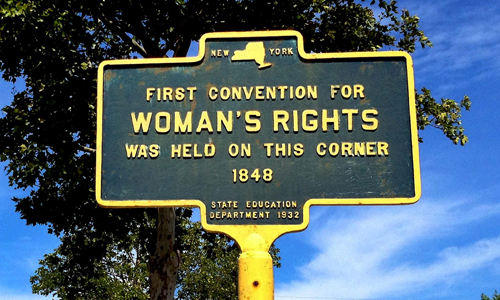Book Review: The Myth of Seneca Falls: Memory and the Women’s Suffrage Movement, 1848-1898

April 13, 2023
The Seneca Falls Convention of 1848 was the start of the women’s rights movement, right? Wrong. It is certainly referred to as such in countless textbooks and used as the starting point from which the 100 year anniversary was determined. In fact, a quick Google search for the first woman’s rights convention will pull up a plethora of information on Seneca Falls. But the truth is that the start of this movement predated the Seneca Falls Convention. So why is it that history remembers this wrong?
You don’t have to be a historian to be invested in getting the story of the past right. By better understanding how history can be curated and how memory can be influenced, we can all become more critical consumers of information.
The author that uncovered this dynamic history, Dr. Tetrault, is an associate professor of history at Carnegie Mellon University and author of “The Myth of Seneca Falls” which focuses on the history of memory in the American women’s suffrage movement.
What even happened?
Seneca Falls did happen. That is not what makes it a myth. Rather, the word “first” or “start” falsely gives Seneca Falls a remarkable place in the memory of women’s history – a place that it did not possess even ten years after it occurred. Instead, at the time, many women’s rights advocates identified the 1850 convention in Worcester, Massachusetts as the start of the movement. They acknowledged Seneca Falls in passing but hadn’t given it the importance that it would come to have. Lucy Stone, prominent women’s rights activist, even contested Seneca Falls as a starting point during the 40th Anniversary celebration of Seneca Falls, commenting on the importance of the work done by Sarah and Angelina Grimké in the as far back as the 1830s. Antoinette Brown Blackwell, speaking at the same convention, even pointed out that she and Lucy Stone had formed a school club at Oberlin College dedicated to women’s rights, including suffrage, between 1846 and 1847.
An Overview of the Book
“The Myth of Seneca Falls: Memory and the Women’s Suffrage Movement, 1848-1898” charts the chaotic and multi-faceted nature of the Women’s Rights movement. Many readers may not be familiar with the multiple national organizations along with the state and regional women’s rights organizations. Dr. Tetrault introduces these in a way that is easy to follow and highlights how they both supported each other and created tension. The movement was characterized by conflict and infighting over how women’s suffrage should be pursued. Some suffragettes were discouraged from pursuing suffrage on a federal level by a 1875 Supreme Court ruling, Minor v. Happersett, and decided to instead focus on gaining women’s suffrage through the tedious path of gaining the right state by state. Others in the movement focused on concepts such as municipal suffrage, school suffrage, or even presidential suffrage where women would vote for the president, but not on any other positions or laws.
Susan B. Anthony was not satisfied by these methods; she maintained the belief that women should be fighting for suffrage on the federal level in the same style as the fifteenth amendment, namely that women’s suffrage should be secured on the federal level via a sweeping amendment. Her dedication to this path is exemplified by the fact that when suffrage for women was finally achieved after her death, it was often referred to as the “Anthony Amendment.” Another important note is that Anthony believed that the 15th amendment, which allowed African Americans to vote, should have surely come after the suffrage of women. Anthony was not fighting for universal suffrage, but rather a suffrage informed with racist, classist, and nativist ideas. Dr. Tetrault acknowledges the positive impact that Anthony had on the pursuit of women’s suffrage, while also pointing out the real ways that she may have harmed the movement.
Susan B. Anthony’s Role
Susan B. Anthony as a historical figure is a focal point of the book. Susan B. Anthony tried to keep the movement unified and to maintain leadership (despite some of her racially charged views), and she constructed the historical narrative around those interests.
Susan B. Anthony, along with Elizabeth Cady Stanton and Matilda Joselyn Gage, led the creation of a historical book “History of Woman Suffrage” which would eventually consist of six volumes, acting as the main source of information about the women’s rights movement. Anthony wrote and curated this history in a way that placed herself in the center and pushed those who opposed her to the edges of women’s history. Not only this, but at the end of her life Anthony set fire to the original documents used to create these volumes of women’s history, leaving only the edited and selected volumes as evidence.
This crafted story of the women’s rights movement was cemented in historical memory through the celebration of women’s rights anniversaries using Seneca Falls as the start date. Tireless promotion of the story at speaking engagements helped to popularize the story. Now it’s been made to seem even more authentic through the designation of a Women’s Rights National Historical Park where the Seneca Falls convention took place.
Book Review
Dr. Tetrault skillfully depicts the most remembered leaders of the women’s rights movement as complexly human, while also painting a picture of the larger than life power that these women held. “The Myth of Seneca Falls” pulls back the curtain on the history that we think we know, and introduces us to a far more complex story of the women’s rights movement and the power of a story. This book could appeal to historians and non-historians alike. Those not familiar with the history will find themselves engrossed in the mere story that varies from what they’ve come to know. Those already interested in the history of the women’s rights movement will be thrilled to see the story so artfully and purposefully written. It is clear that Dr. Tetrault has painstakingly read through a mass of primary sources to paint a complete picture of how the historical memory of Seneca Falls solidified over time.
So What?
This history of the women’s rights movement might seem irrelevant to the modern day. You might wonder if it’s worth reassessing what you think you know about the women’s rights movement. In an effort to make our activism more intersectional however, we must understand the foundations of the modern day. By better understanding how and why Seneca Falls became so important in historical memory we can purposefully craft our own history to be more inclusive while recognizing how potent history can be in pushing social change.







